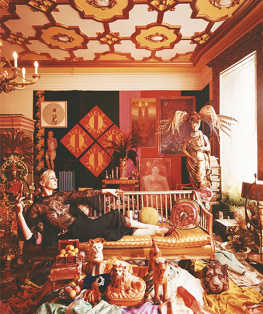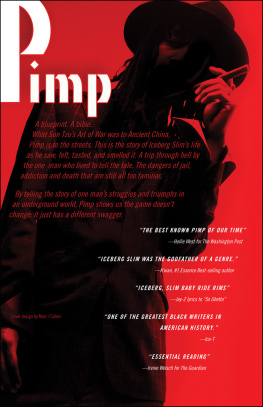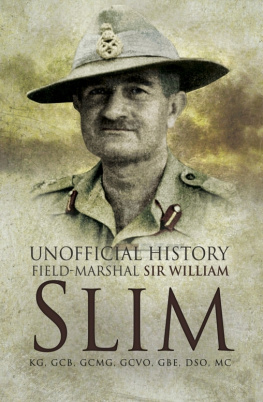
Mrs. A. Atwater Kent Jr. (the former Hope Hewlett Parkhurst) at H. Loy Andersons pool, Palm Beach, circa 1955. A. Atwater Kent, her father-in-law, was the inventor who pioneered the home radio.

Actress Dee Hartford, Jamaica, 1958. See also .


above and next Anne Bindon, model and competitive swimmer, stretches her legs at Long Bay Beach, Bermuda, 1955.

CONTENTS
INTRODUCTION
Youre Going to Love Me and Youre Going to Hate Me
IN THE SUMMER OF 1977 the celebrated photographer Slim Aarons was lunching at the magnificent Goldener Hirsch Hotel in Salzburg with Princess Grace of Monaco and her daughter Caroline. At one point, as he later told the story time and again, Grace was struck by what she thought was a wonderful idea: Oh, Slim, why not hire Caroline to work with you? You two could travel around the world together! Caroline excitedly nodded her approval. As Slim recounted the story his chest puffed ever so slightly, his posture corrected, and a devilish smile crept across his face. Why, what a wonderful idea, Grace, he replied, making it clear he was on a first-name basis with the princess and fully in command. But theres just one question, he said. He already knew the answer, but he strung it along, luxuriating in it. Caroline, he asked, leveling his gaze at her, can you get up in the mornings early? Every morning? They both looked at him, perplexed, so the story went, and shortly thereafter the subject changed.
When it came to his work ethic, Slim Aarons made no concessionsnot even to princesses. Several years later I would learn this firsthand, after meeting Slim when he stopped by my mothers Park Avenue apartment for an informal interview. He was looking for a new sidekick; I was considering a job change.
Slim was exactly as I will always remember him: upbeat, self-satisfied, and wearing a boyish grin that was one part Tom Sawyer, one part Huck Finn. We exchanged a bit of small talk as Slim gulped down a ginger alehis drink of choice no matter where in the world he was. And never one to equivocate, he began a deluge of questions that had to be answered immediately. Can you be ready to leave with little advance notice? Is your passport in order? Can you stand the sun? Can you write? Can you walk up hills at high altitudes? Do you speak any languages? Can you get up in the morning, early? Every morning? Um, yes, I stammered, taken aback (though intrigued, of course). I will confess at this point: Id never heard of Slim Aarons. Id been working on a cattle ranch in Oklahoma since graduating from college and had no clue about the famed, longtime Roving Editor of Town & Country magazine, who was by then in his early fifties.
I thought he was finished, but then came his list of rules: No heavy suitcases, no tennis rackets, no hairdresser appointments, no minibar tabs, no shopping, no dry cleaning, no days off, no boyfriends, no sightseeing, and for Gods sakeno cameras. Not a problem, I said as I shook my head.
My unqualified assent to his list of demands must have been convincing for, after a bit more small talk, he finally stood up to leave, signaling the end of the interview. At the door, as we shook hands, he looked me squarely in the eyes and told me in so many words that Id gotten the job: Youre going to love me and youre going to hate me.
So began a working relationship that would span more than ten years, by the end of which I would move with my young family not far from Slims home in Katonah, New York. He would become a surrogate grandfather to my two daughters and remain a great friend until his death in 2006. By the end of that decade, Slim and I had logged upwards of four hundred thousand miles of travel, exploring some of the most dazzling enclaves of exclusivity in the world and reporting on the people who frequented them.
ABOUT THIS BOOK
Slims visual narratives give us an intimate glimpse into the world of the upper classes and their rituals in the pursuit of leisure. That his half century of work continues to captivate successive generations of admirersand that this is the fifth book published on his photographyreveals not only a yearning for an irretrievable time gone by but also a universal fascination with the seemingly forbidden worlds of wealth and privilege.

Slims uncompromising tenacity in getting the shot was legendary; here he is perched atop an extension ladder to photograph starlet Mara Lane (see ) by the Sands Hotel pool, Las Vegas, 1954.

Two of the extraordinary women who shared Slims life were his wife Rita and his daughter Mary. Rita is shown in Monaco, 1956 (left), and Mary is pictured in Bedford, New York, in 1960 (right).
The collection showcased in this book has been culled from Slims vast body of work with the goal of examining his photography of women, the principal subjects of his work. Another objective of this collection is to feature little-known material never before published in book form. Many of these previously unpublished images provide fresh representations of Slims vision and allow the viewer to observe his attention to detail.
In this book you will find a host of extraordinary womenamong them, the women who shared Slims life and work: his daughter, Mary Aarons (above ).
Featuring a broad sampling of Slims work, the book spans every decade in which he photographed, with pictures that were taken in North America, South America, Europe (including Eastern Europe), Asia, and parts beyond. Of course, any book on the women Slim photographed throughout his career must include his most iconic images of renowned figures, such as Babe Paley ().
In this collection of photographs, the exclusive realm that Slim so deftly navigated is once again revealed, but with a tight focus on the women who inhabited this world. In addition to these images, to give further context and insight, Ive recounted in many of the captions, where relevant, my observations gleaned from working with him for more than a decade.
SLIMS EARLY YEARS
Its dizzying to think of the precipice upon which young Slim Aarons stood when he started out in the late 1940s, camera in hand, ready to take on the world. His half century of work would witness societal shifts that were monumental: the dawn of photojournalism, the rise of commercial air travel and birth of the jet set, the global sweep of television, civil rights, the womens movement, the pill, AIDS, color photography, and the invention of the Internet. Equally astonishing were the changes in the way society viewed women. At the start of his career, Slims female subjects were primarily society ladies and movie stars. His 1955 photograph of socialite C. Z. Guest poolside in Palm Beach (see ) would capture the imagination of a generation and become the archetype for Slims female subjects. By the end of his career in the early 1990s, however, he had photographed an array of women who played far more varied roles in society: ranchers, lawyers, poets, politicians, surgeons, historians, race car drivers, big game hunters, philanthropists, opera singers, designers, and royalty in their own right.
Next page
















